To develop a more clear understanding of how gluPerspective() and gluLookAt() works, I recommend playing with the tutorials from Nate Robins, more specifically the projection demo.
Trust me, this is the droid you are looking for!

Anyway, a few days ago I wrote a spiced up version of Nehe lesson 5 (3D Shapes) in Qt:
GLWidget.cpp:
#include "GLWidget.h"
#include <iostream>
#include <QKeyEvent>
#include <QTimer>
GLWidget::GLWidget(QWidget *parent)
: QGLWidget(parent)
{
angle_tri = 0.f;
angle_quad = 0.f;
_eye_x = 0.f;
_eye_y = 0.f;
_mouse_is_moving = false;
_width = 0;
_height = 0;
}
GLWidget::~GLWidget()
{
}
void GLWidget::_tick()
{
update(); // triggers paintGL()
QTimer::singleShot(33, this, SLOT(_tick()));
}
void GLWidget::initializeGL()
{
// glShadeModel(GL_SMOOTH); // Enable Smooth Shading
glClearColor(0.0f, 0.0f, 0.0f, 1.0f); // Black Background
// glClearDepth(1.0f); // Depth Buffer Setup
// glEnable(GL_DEPTH_TEST); // Enables Depth Testing
// glDepthFunc(GL_LEQUAL); // The Type Of Depth Testing To Do
// glEnable ( GL_COLOR_MATERIAL );
// glHint(GL_PERSPECTIVE_CORRECTION_HINT, GL_NICEST);
_tick();
}
void GLWidget::paintGL()
{
if (_mouse_is_moving)
{
glMatrixMode ( GL_PROJECTION ); // Select The Projection Matrix
glLoadIdentity ( ); // Reset The Projection Matrix
gluPerspective ( 60, ( float ) _width / ( float ) _height, 1.0, 50.0 );
gluLookAt(0.0, 0.0, 2.0, // eye
_eye_x, _eye_y, 0.0, // center
0.0, 1.0, 0.0); // up
std::cout << "paintGL: eye " << _eye_x << "," << _eye_y << std::endl;
}
glClear(GL_COLOR_BUFFER_BIT | GL_DEPTH_BUFFER_BIT); // Clear Screen And Depth Buffer
glMatrixMode ( GL_MODELVIEW ); // Select The Model View Matrix
glLoadIdentity(); // Reset The Current Modelview Matrix
glPushMatrix();
glTranslatef(-1.5f,0.0f,-6.0f); // Move Left 1.5 Units And Into The Screen 6.0
glRotatef(angle_tri,0.0f,1.0f,0.0f); // Rotate The Triangle On The Y axis
glBegin(GL_TRIANGLES); // Drawing Using Triangles
glColor3f(1.0f,0.0f,0.0f); // Red
glVertex3f( 0.0f, 1.0f, 0.0f); // Top Of Triangle (Front)
glColor3f(0.0f,1.0f,0.0f); // Green
glVertex3f(-1.0f,-1.0f, 1.0f); // Left Of Triangle (Front)
glColor3f(0.0f,0.0f,1.0f); // Blue
glVertex3f( 1.0f,-1.0f, 1.0f); // Right Of Triangle (Front)
glColor3f(1.0f,0.0f,0.0f); // Red
glVertex3f( 0.0f, 1.0f, 0.0f); // Top Of Triangle (Right)
glColor3f(0.0f,0.0f,1.0f); // Blue
glVertex3f( 1.0f,-1.0f, 1.0f); // Left Of Triangle (Right)
glColor3f(0.0f,1.0f,0.0f); // Green
glVertex3f( 1.0f,-1.0f, -1.0f); // Right Of Triangle (Right)
glColor3f(1.0f,0.0f,0.0f); // Red
glVertex3f( 0.0f, 1.0f, 0.0f); // Top Of Triangle (Back)
glColor3f(0.0f,1.0f,0.0f); // Green
glVertex3f( 1.0f,-1.0f, -1.0f); // Left Of Triangle (Back)
glColor3f(0.0f,0.0f,1.0f); // Blue
glVertex3f(-1.0f,-1.0f, -1.0f); // Right Of Triangle (Back)
glColor3f(1.0f,0.0f,0.0f); // Red
glVertex3f( 0.0f, 1.0f, 0.0f); // Top Of Triangle (Left)
glColor3f(0.0f,0.0f,1.0f); // Blue
glVertex3f(-1.0f,-1.0f,-1.0f); // Left Of Triangle (Left)
glColor3f(0.0f,1.0f,0.0f); // Green
glVertex3f(-1.0f,-1.0f, 1.0f); // Right Of Triangle (Left)
glEnd(); // Finished Drawing The Triangle
glLoadIdentity(); // Reset The Current Modelview Matrix
glTranslatef(1.5f,0.0f,-9.0f); // Move Right 1.5 Units And Into The Screen 6.0
glRotatef(angle_quad,1.0f,0.0f,0.0f); // Rotate The Quad On The X axis
glBegin(GL_QUADS); // Draw A Quad
glColor3f(0.0f,1.0f,0.0f); // Set The Color To Green
glVertex3f( 1.0f, 1.0f,-1.0f); // Top Right Of The Quad (Top)
glVertex3f(-1.0f, 1.0f,-1.0f); // Top Left Of The Quad (Top)
glVertex3f(-1.0f, 1.0f, 1.0f); // Bottom Left Of The Quad (Top)
glVertex3f( 1.0f, 1.0f, 1.0f); // Bottom Right Of The Quad (Top)
glColor3f(1.0f,0.5f,0.0f); // Set The Color To Orange
glVertex3f( 1.0f,-1.0f, 1.0f); // Top Right Of The Quad (Bottom)
glVertex3f(-1.0f,-1.0f, 1.0f); // Top Left Of The Quad (Bottom)
glVertex3f(-1.0f,-1.0f,-1.0f); // Bottom Left Of The Quad (Bottom)
glVertex3f( 1.0f,-1.0f,-1.0f); // Bottom Right Of The Quad (Bottom)
glColor3f(1.0f,0.0f,0.0f); // Set The Color To Red
glVertex3f( 1.0f, 1.0f, 1.0f); // Top Right Of The Quad (Front)
glVertex3f(-1.0f, 1.0f, 1.0f); // Top Left Of The Quad (Front)
glVertex3f(-1.0f,-1.0f, 1.0f); // Bottom Left Of The Quad (Front)
glVertex3f( 1.0f,-1.0f, 1.0f); // Bottom Right Of The Quad (Front)
glColor3f(1.0f,1.0f,0.0f); // Set The Color To Yellow
glVertex3f( 1.0f,-1.0f,-1.0f); // Bottom Left Of The Quad (Back)
glVertex3f(-1.0f,-1.0f,-1.0f); // Bottom Right Of The Quad (Back)
glVertex3f(-1.0f, 1.0f,-1.0f); // Top Right Of The Quad (Back)
glVertex3f( 1.0f, 1.0f,-1.0f); // Top Left Of The Quad (Back)
glColor3f(0.0f,0.0f,1.0f); // Set The Color To Blue
glVertex3f(-1.0f, 1.0f, 1.0f); // Top Right Of The Quad (Left)
glVertex3f(-1.0f, 1.0f,-1.0f); // Top Left Of The Quad (Left)
glVertex3f(-1.0f,-1.0f,-1.0f); // Bottom Left Of The Quad (Left)
glVertex3f(-1.0f,-1.0f, 1.0f); // Bottom Right Of The Quad (Left)
glColor3f(1.0f,0.0f,1.0f); // Set The Color To Violet
glVertex3f( 1.0f, 1.0f,-1.0f); // Top Right Of The Quad (Right)
glVertex3f( 1.0f, 1.0f, 1.0f); // Top Left Of The Quad (Right)
glVertex3f( 1.0f,-1.0f, 1.0f); // Bottom Left Of The Quad (Right)
glVertex3f( 1.0f,-1.0f,-1.0f); // Bottom Right Of The Quad (Right)
glEnd(); // Done Drawing The Quad
glPopMatrix();
angle_tri += 3.2f; // Increase The Rotation Variable For The Triangle ( NEW )
angle_quad -= 3.15f; // Decrease The Rotation Variable For The Quad ( NEW )
}
void GLWidget::resizeGL( int w, int h)
{
_width = w;
_height = h;
glViewport ( 0, 0, w, h );
glMatrixMode ( GL_PROJECTION ); // Select The Projection Matrix
glLoadIdentity ( ); // Reset The Projection Matrix
if ( h==0 ) // Calculate The Aspect Ratio Of The Window
gluPerspective ( 60, ( float ) w, 1.0, 50.0 );
else
gluPerspective ( 60, ( float ) w / ( float ) h, 1.0, 50.0 );
gluLookAt(0.0, 0.0, 2.0, // eye
0.0, 0.0, 0.0, // center
0.0, 1.0, 0.0); // up
glMatrixMode ( GL_MODELVIEW ); // Select The Model View Matrix
glLoadIdentity ( ); // Reset The Model View Matrix
}
void GLWidget::mousePressEvent(QMouseEvent *event)
{
std::cout << "mousePressEvent:" << std::endl;
_mouse_is_moving = true;
}
void GLWidget::mouseReleaseEvent(QMouseEvent *event)
{
std::cout << "mouseReleaseEvent:" << std::endl;
_mouse_is_moving = false;
}
void GLWidget::mouseMoveEvent(QMouseEvent *event)
{
if (_mouse_x == 0)
_mouse_x = event->pos().x();
if (_mouse_y == 0)
_mouse_y = event->pos().y();
std::cout << "mouseMoveEvent: " << event->pos().x() << "," << event->pos().y() << std::endl;
if (event->pos().x() > _mouse_x)
{
_eye_x += 0.10;
}
else if (event->pos().x() < _mouse_x)
{
_eye_x -= 0.10;
}
if (event->pos().y() > _mouse_y)
{
_eye_y += 0.10;
}
else if (event->pos().y() < _mouse_y)
{
_eye_y -= 0.10;
}
_mouse_x = event->pos().x();
_mouse_y = event->pos().y();
}
GLWidget.h:
#include <QGLWidget>
class GLWidget : public QGLWidget
{
Q_OBJECT
public:
explicit GLWidget(QWidget* parent = 0);
virtual ~GLWidget();
/* OpenGL initialization, viewport resizing, and painting */
void initializeGL();
void paintGL();
void resizeGL( int width, int height);
/* enable the user to interact directly with the scene using the mouse */
void mousePressEvent(QMouseEvent *event);
void mouseReleaseEvent(QMouseEvent *event);
void mouseMoveEvent(QMouseEvent *event);
private:
float angle_tri; // Angle For The Triangle
float angle_quad; // Angle For The Quad
float _eye_x;
float _eye_y;
bool _mouse_is_moving;
int _mouse_x;
int _mouse_y;
int _width;
int _height;
protected slots:
void _tick();
};
main.cpp:
#include <QApplication>
#include "glwidget.h"
int main(int argc, char* argv[])
{
QApplication app(argc, argv);
GLWidget gl_widget;
gl_widget.show();
return app.exec();
}


